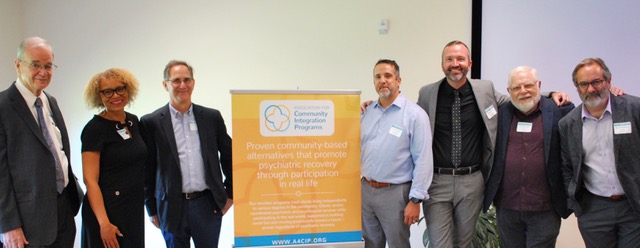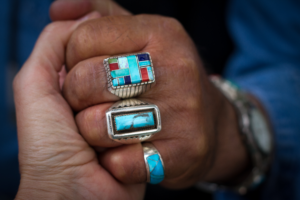
Hope is the key driver of personal change. Hope enables us to take action toward a goal and to trust that we can keep moving toward it. However, in the very act of bringing us closer to our goals, hope brings us closer to the potential disappointment of not reaching them. Fueled by hope, the higher the summit we attempt, the more injurious the possible fall into despair.
Thus, when we hope, we risk despair. That risk is at the center of all change. As behavioral health professionals, our task is to help clients take that risk – again and again.
Despite the key importance of hope to personal growth, it is neglected in standard treatment. There is an identifiable gap in many psychotherapies and skills-based training regarding this concept. Too often, hope is seen as an essential psychological outcome, but not the core of the work.
The fifth Community Integration Conference, held on June 20, 2019, was designed to start to correct this gap. At the conference, which took place at The Menninger Clinic in Houston, Texas, attendees were inspired to explore ways of integrating hope-based approaches into their work, bridging the treatment gap in using the value of hope as the central driver of personal growth. Participants also explored how the community integration therapeutic model is a fertile ground for the rebirth of hope – and change — even in people long mired in hopelessness. The event enjoyed record-breaking attendance.
Speakers Hold a Mirror Up to Hope
Conference presenters discussed the various faces of hope and its seminal connection to personal change. They addressed an audience of physicians, psychologists, social workers, licensed professional counselors, addictions professionals, and providers and consumers of behavioral health services.
In his presentation entitled “Hope is a Verb,” Matt Estey, LCSW, Program Director of Menninger 360, noted that for Programs for Assertive Community Treatment (PACT), “hope is the integral action step, the cornerstone to creating, restoring and enhancing life.”
Dr. Jon G. Allen, Clinical Professor in the Voluntary Faculty of the Department of Psychiatry and Behavioral Sciences at Baylor College of Medicine, spoke on “Hope in the Menninger Tradition and Beyond.” He considered hope in the context of a “sadly common clinical challenge: trauma in attachment relationships…Restoring a feeling of security through treatment relationships, ideally buttressed by a healing community, is a central foundation of hope.”
In his talk, “Hope, Fear of Hope and Coping,” Kent Harber, PhD, of Rutgers University, discussed his trailblazing clinical research with Dr. Ross Ellenhorn into the new concept of fear of hope. “Our research included the creation and use of the Fear of Hope self-report measure to understand how hope and fear of hope together affect well-being.”
Chyrell Bellamy, PhD, MSW, Associate Professor at Yale School of Medicine’s Department of Psychiatry, Program for Recovery and Community Health, and that program’s Director of Peer Services/Research, spoke on “Hope for the Feared Selves: From the Individual to the Collective. Moving Toward Meaningful Social/Community Inclusion and Recovery.” Dr. Bellamy noted that “For many living with mental illness…individualistic interventions may be a start, but…community approaches offer a sense of belonging and citizenship that are important to our ways of being and living.”
Ross Ellenhorn, PhD, LICSW, president of A4CIP and CEO/Founder of Ellenhorn, LLC, spoke on “Dreams Deferred: Hope, Fear of Hope and the Psychological Consequences of Serious or Repeated Disappointment.” Because treaters often view a client’s inability to move forward as an innate psychological trait rather than situationally based, said Dr. Ellenhorn, “much of the dysfunction and lack of motivation in our clients is not merely rooted in psychiatric problems, but is iatrogenic, that is, created by the way we treat them.”
“The Conference Was Wonderful….All the Work Everyone is Doing!”
(An attendee)
When reflecting on the conference, attendees spoke excitedly about insights gained into the heretofore unexplored areas of hope and fear of hope. They described feeling reinvigorated by collegial sharing about the community integration model and its special value for people who seem profoundly stuck.
Says Matt Estey of the Menninger Clinic, “Since the conference, our [PACT] team has been having rich discussions about hope and fear of hope. Also with clients – and we’ve been quite overt with it, asking: ‘Are you experiencing life this way?’ We work with folks who’ve ‘done’ a lot of treatment, and are often labelled ‘treatment-resistant’ or “failed in treatment.’ This seems unfair. Fear of hope is more helpful in illuminating why a person is so stuck.”
“This illness is stigmatized,” reflects Dr. Bellamy of Yale, “And for many of us, it causes you to go inward. It’s hard to muster that sense of hope. There’s something to collectiveness in terms of hope. Hope doesn’t work in a vacuum, but is inspired and created by being around others. That’s community integration.”
Dr. Jon Allen of Baylor College of Medicine comments, “The conference opened my eyes and my mind to a way of working with people after hospitalization. Community integration means a person is no longer out there alone. They have the support they need. That makes hope possible and less frightening. Our crazy culture is so individualistic in orientation. People who have been ill for decades leave a hospital and are supposed to make it on their own. It’s a profoundly unhelpful way to be, yet one that’s prized.”
Dr. Allen adds, “Therapies lag behind in helping people function in their lives. Health isn’t the absence of illness; health is a whole other continuum apart from the illness continuum. Health consists of flourishing at one end — languishing at the other. Community integration programs are helping people who are free of the acute phase of illness move toward living their lives well.”
Eric Friedland-Kays, MA, Senior Clinician and Senior Administrator at the Windhorse program, notes, “I tremendously appreciated the focus on hope and fear of hope. Dr. Harber said having hope often means committing oneself to uncertain outcomes. I love this way of saying it. In reality, there’s so much uncertainty. We need to have faith in ourselves and the world to take a step. In the community integration setting, we’re able to support folks in dealing with the actual uncertainties of the real world and to play with these real-life scenarios. By supporting someone in taking real steps, forming real relationships, all within a relatively safe setting, we help them move along.”
Dr. Ellenhorn comments, “Hopelessness is now called depression. But the minute you start seeing a human being as a human being, and you think about other words — like hope and fear, connection, feeling valued, purpose – treatment becomes much more world-based. That’s where community integration makes a unique contribution.”
Notes Jeanette Spires, MS, MSED, NCSP, an educational consultant and nationally certified school psychologist, “Before the conference, I had never thought of hope as on a continuum with despair. Much of my work involves convincing people who are resisting treatment to consider it. Now I’m thinking differently about how I might present treatment. You don’t want to create false hope. Yet you also want them to be validated and, in the end, excited about life.”
Dr. Bellamy adds, “A variety of supports! That’s what I love about community integration.”



